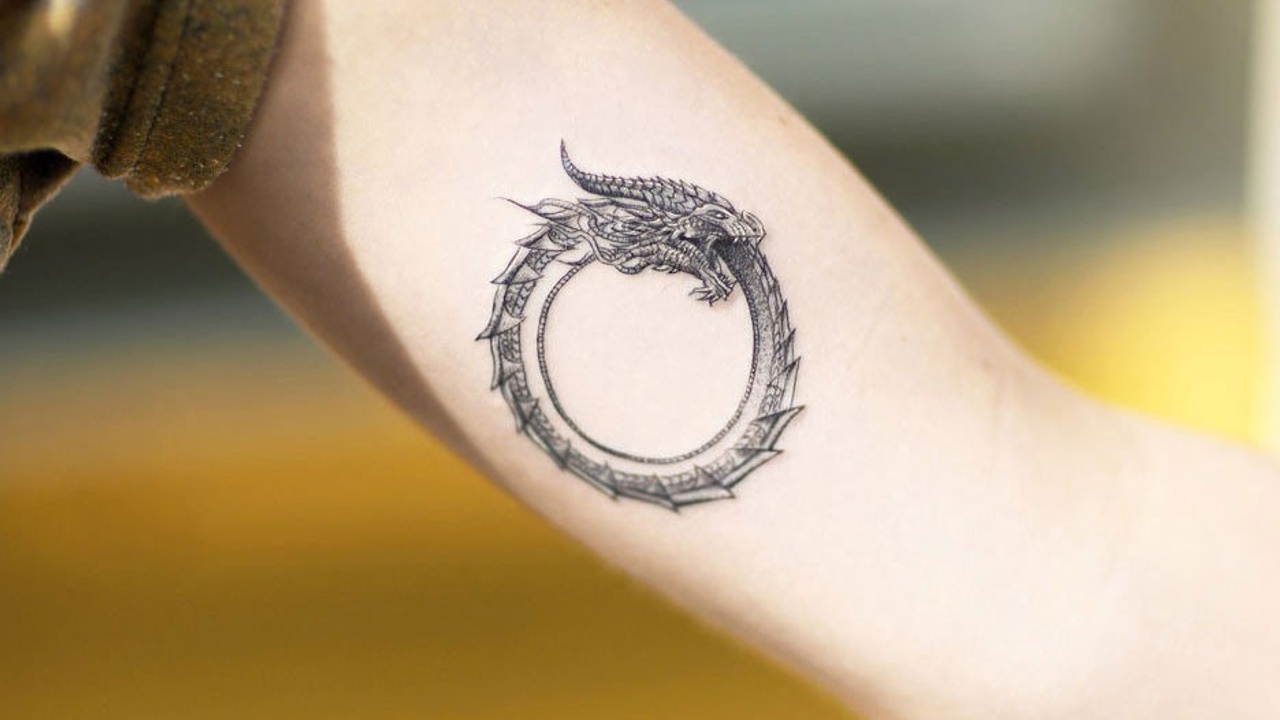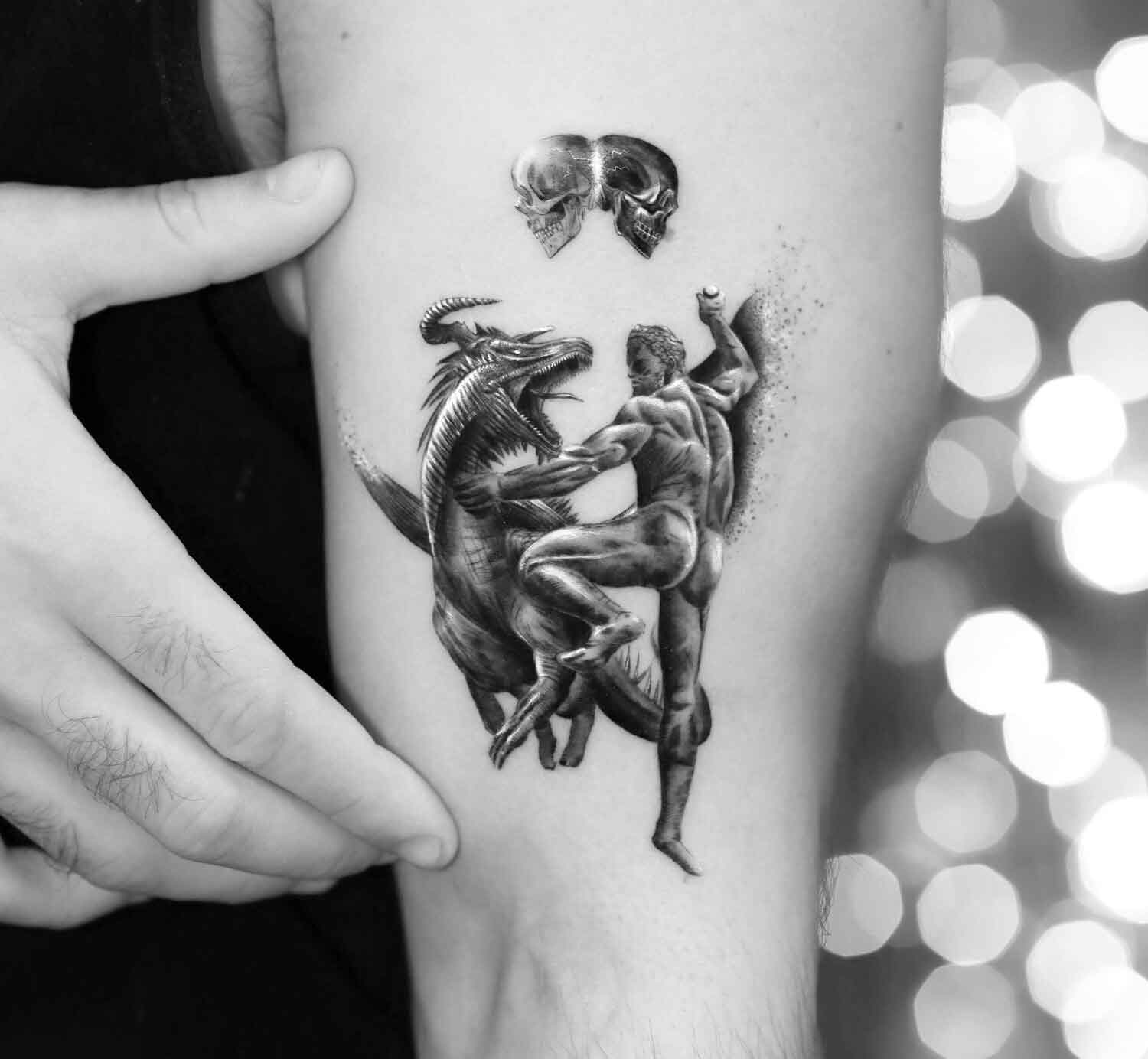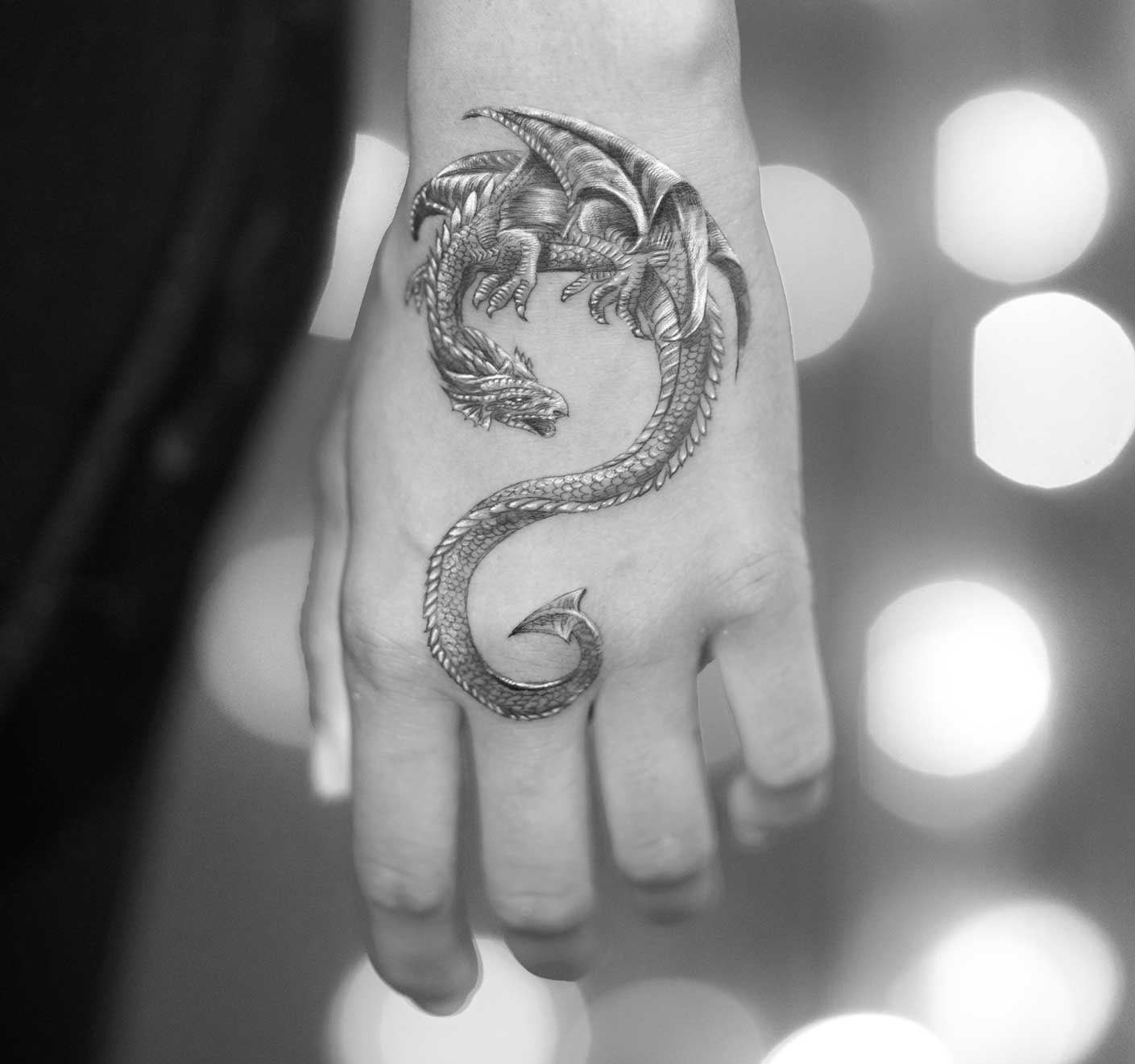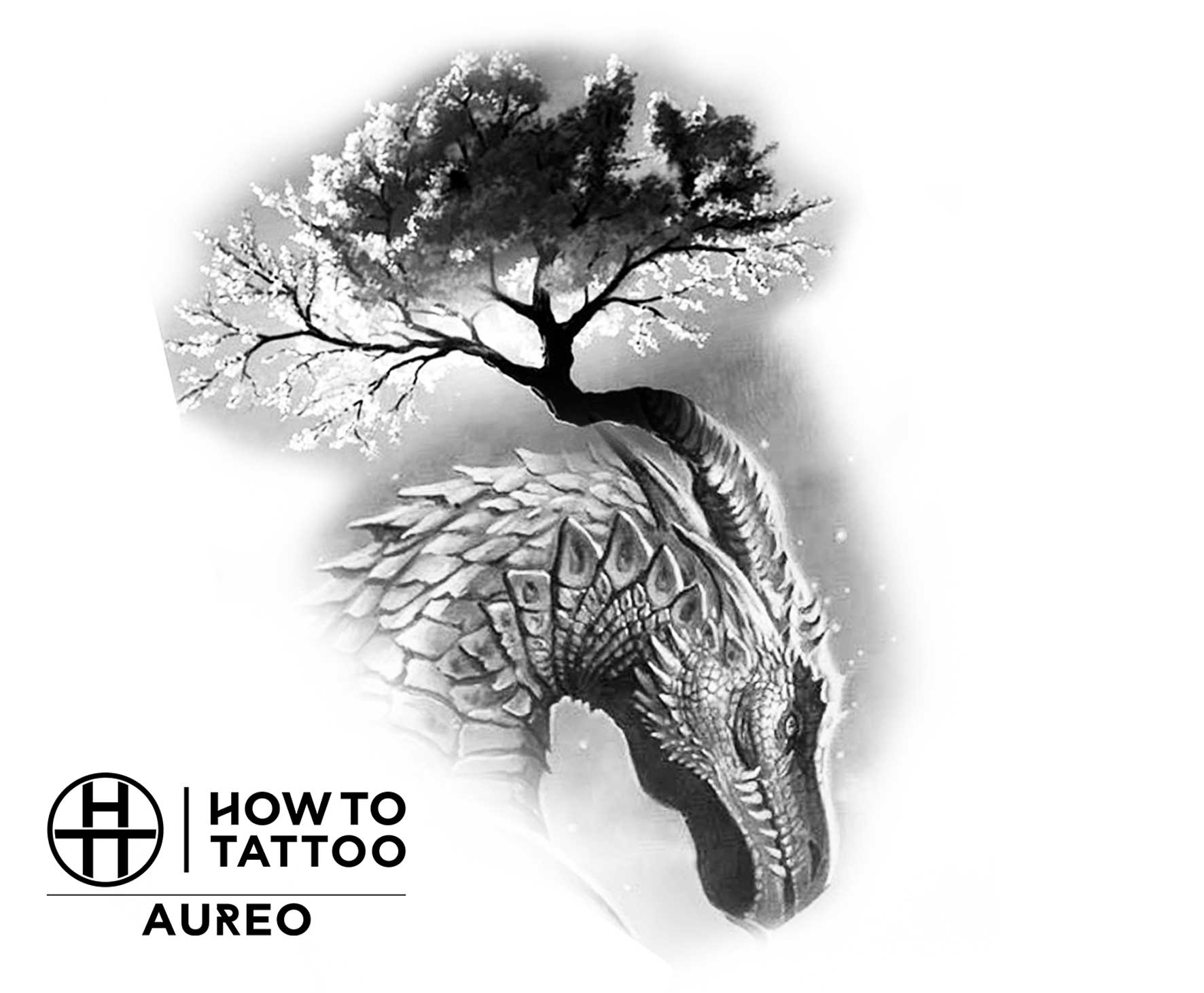How to Draw a Dragon Tattoo

These mythical creatures have played a key role in our childhood fantasies for thousands of years, nearly 4,000 to be exact. And it could perhaps be for this reason that we desire nothing more than to memorialize their glory and captivating beauty by adorning them on our flesh for eternity.
Over the past couple of centuries, the style of dragon tattoos has undergone several metamorphoses throughout the East and West alike.
Undoubtedly the two most fundamental qualities to master when drawing this creature, no matter what style you’re attempting, are the intricate scales and fierce expression.
A Brief History of Dragons in Art History

(Tattoos by Alessandro Capozzi - AKA Alex Aureo)
Before we dive into the tips and tricks on how to successfully draw a dragon, it’s worth covering a bit of the history of dragons. The exact origins of the dragon in art historical terms can’t be precisely pinpointed given that each ancient culture around the world interpreted the mighty beast in their own unique way.
We do know that in the western world the etymology of the word ‘dragon’ derives from the Greek word for ‘drakon’ meaning a monumental serpent-like monster. Some of the earliest known records we have of western cultures mentioning this fascinating creature can be found in Mesopotamian and Greek literature such as The Epic of Gilgamesh from the 22nd century BC which featured Humbaba, a fire-spewing, fanged monster or Homer’s Iliad from the 11th century BC in which one of the characters sports a ‘drakon’ on his belt-buckle.
Heading east into Persia and India, a similar beast would come to symbolize, war, drought and suffering. If we head even further east towards China, during the Shang and Zhou dynasties, there are enormous, four-legged serpents being painted on tapestries, ceramics and more. However, their version of a dragon was associated with auspicious fortune and strength, making it one of the most powerful zodiac symbols to this day.
In the 7th century Japan, a formidable water god bearing the same shape took center stage in many folklore legends and would, later on, appear throughout many Ukiyo-e (floating world) prints during the Edo period. Also in Korea, the presence of dragons was commonplace for centuries adopting more specific attributes like a long beard and 81 scales (linked to lucky number 9). The most fascinating aspect of dragons is that despite some subtle differences in appearance, (legless, four-legged, winged, swimmer, flyer, scales, fur, etc), more or less it has always been imagined around the world as a colossal, snake-shaped beast with a snout. The only major difference between western and eastern cultures is that in the west, the dragon is typically depicted as a demonic, fire-breathing animal whereas in the east it is often revered as an enchanting water god that brings abundance to the land.
Artistic Characteristics of the Dragon
 (Tattoos by Alessandro Capozzi - AKA Alex Aureo)
(Tattoos by Alessandro Capozzi - AKA Alex Aureo)
Studying the different cultural variations of the dragon will help you as an artist to design the right version that lives up to the prospective client’s fantasy. In the world of tattoos, a ‘classic dragon’ is usually associated with the ‘Ryu’ traditional Japanese style that many Yakuza gangsters used. A client could perhaps be imagining a western ‘Old School’ style which was inspired by Chinese and Japanese cultures. Maybe the client is picturing a medieval-style dragon that is predominantly represented in the west. Artists should ask their clients to be as detailed and creative as possible when describing their dream dragon tattoo. If we start from east to west we can start by thinking about the way the Chinese, Japanese and Koreans portray a dragon. Symbolically, the artist needs to capture the beast’s wisdom, perseverance and majestic individuality.
We know that throughout their history in the east they are nearly always painted dynamically with writhing, serpent-like movements. In nearly all cases the animal has four legs, two towards the front and two towards the tail. Each leg finishes with 3 to 5 sharp claws that are flexed and fanned out. When observing the eyes, the pupils are piercing and are sometimes rimmed with red or yellow irises. Although they can fly, eastern dragons don’t have wings! They typically have mohawk-style spikes down the spine, a lion’s mane with a whisker beared and sometimes horns or antlers. Although there are some parts of the body embellished with hair or fur, the body is always scaley. The scales are crucial when drawing an eastern dragon because they follow a rhythmic pattern and are colorful (but an artist can still accurately tattoo these details in black and gray).
Moving on towards the west we can see that many traits overlap but there are also several distinctions. The two most notable differences being the enormous, leathery bat wings and the ferocious yet statuesque poses. While in ancient times the dragon assumed a serpent-like shape without legs, we can see that as centuries progressed, ‘dinosaur’ legs begin to sprout; thick, sturdy thighs that taper to form vulture talons. The eyes differ greatly from the eastern version, they tend to glow brightly and have little to no pupil. The tip of the tail looks almost like a devil’s scepter or a spade. On the opposite end, the mouth is wide open in midst of blowing fire with a wild, narrow, forked tongue sticking out. Their teeth are razor sharp but don’t necessarily have two vampire fangs as they appear in the east. Some fairytales describe the muzzle as a beak whereas most of the time they are featured with a snout. Subtle details like smoke can be seen lingering from the nostrils if the artist wants to make a dynamic portrait. Their bellies in medieval descriptions tend to be ribbed like alligators. Dragon bodies are always much more muscular in the west compared to eastern images. When drawing a dragon, no matter if the artist is inspired by a more eastern or western perspective, the two qualities that require the most attention are the texture of the scales, fur or rough flesh and the snarling expression.
Background and Extra Details

(Tattoos by Alessandro Capozzi - AKA Alex Aureo)
Concentrating on the image we’ve painted in our minds of a western dragon, we can easily fantasize about the setting: a dark, damp dungeon in the depths of a stone castle. Perhaps the dragon has his ankles shackled to the ground to prevent it from flying away. There are tales of dragons protecting treasure chests filled with gold and jewels that could enrich the overall tattoo and allow the artist to play with more colors. We may also envision a volcanic eruption with the dragon soaring high in the sky expelling flames. These do not correlate with the eastern dragon’s narrative. For this story we will need to picture billowing clouds engorged by the rain building up, roaring tsunami waves in the sea and gusts of wind blowing through the dragon’s mane. A plump opalescent pearl may be clenched between its paws or tucked under its chin, a symbol of prosperity and immortality. Two very different settings for one almighty beast.
Tools to Draw a Dragon Tattoo

(Design by Alessandro Capozzi - AKA Alex Aureo)
With these vivid depictions in mind it’s time to get started with our tattoo designs. After having established the cultural rendition that appeals most to the client, the artist must consider the location of the dragon tattoo in relation to the movement of the dragon’s body. When drawing a western dragon in profile, do not align the wings because you will risk the image looking two dimensional and flat. Instead try to open the wings wider creating more space and destinction between the two subjects. Avoid static poses on all fours or lying down because they require a straight line at the base to create the ground. With time, depending on the body type, the line could end up crooked as we age and fluctuate weight. Opt for an energetic pose that can retain its beauty even as the canvas changes. From this point the artist may begin gathering a portfolio of inspirational references that can be used to personalize the client’s dragon tattoo. If you as an artist are already skilled at drawing dragons or similar animals you may want to play around with the idea of sketching out designs with pen and paper. Some useful websites that we suggest for browsing ideas are Pinterest, Instagram and Google. Once the artist has successfully found all the characteristics that suit the client’s desires, the images can be combined on applications like Photoshop. This step is important when following a tracing method that is used most often in the tattoo world today. These types of programs allow the artist to create a collage effect of different images while being able to modify, erase and enhance different layers to create one uniformed subject. The last step would be to upload the final recreation to Procreate or a similar illustration app in order to create harmony, symmetry ecetera between the collaged images. For examples on how to specifically use Procreate to customize a drawing for a tattoo, subscribe to Aureo Roma’s academy, How to Tattoo for lessons.
In Conclusion
We hope you’ve enjoyed this brief introduction to how to draw dragon tattoos. For further questions, please ask away in the comment section listed below and make sure to enlist in How to Tattoo for detailed, step-by-step tutorials. Feel free to share your dragon tattoos with other artists as well to keep the creative juices flowing!
If you are serious about becoming a tattoo artist and want to not only draw dragons but to tattoo them perfectly as well join How To Tattoo Aureo, the perfect and best online tattoo academy! With hours of learning material, live tattoos, and every single technique explained and shown. Join today!
Start your tattoo career in the best way possible!
Join our mailing list to receive the latest news and updates. Your information will not be shared.

